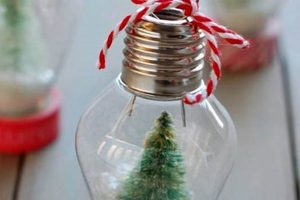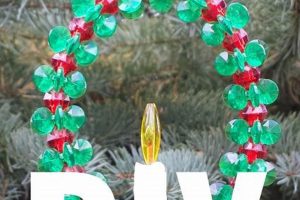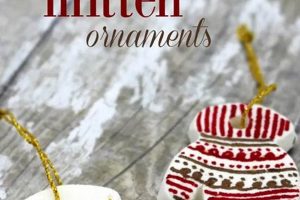Creating personalized holiday decorations using photographs is a crafting activity that results in unique keepsakes. These crafted items typically involve incorporating printed images into various decorative forms intended for display on seasonal trees or within the home.
This form of personalized crafting provides significant sentimental value, capturing memories and milestones to be revisited annually. Historically, handcrafted ornaments have served as tangible representations of family history, evolving from simple homemade adornments to elaborate artistic expressions, offering a personalized alternative to mass-produced decorations.
The subsequent sections will explore different methods for fabricating these personalized photographic adornments, providing practical guidance and design considerations for successfully creating memorable and visually appealing holiday decorations.
Tips for Personalized Photo Adornment Creation
The following outlines key considerations for effectively creating personalized photographic decorations, ensuring lasting quality and visual appeal.
Tip 1: Image Selection: Choose high-resolution photographs. Low-resolution images will appear pixelated when enlarged or printed, diminishing the final product’s quality.
Tip 2: Material Quality: Opt for acid-free paper or archival-quality printing when incorporating paper components. This prevents discoloration and deterioration over time.
Tip 3: Protective Sealant: Apply a sealant, such as decoupage glue or a clear acrylic spray, to protect the image from moisture and fading. Ensure the sealant is specifically designed for photographs to avoid damage.
Tip 4: Secure Attachment: Employ durable adhesives suitable for the materials being used. For example, a strong craft glue is appropriate for attaching photos to wooden surfaces, while a specialized adhesive may be required for glass.
Tip 5: Consider Ornament Weight: When selecting base materials, be mindful of weight. Heavy materials can strain tree branches. Lighter options, such as thin wood or plastic, are often preferable.
Tip 6: Edge Finishing: Smooth sharp edges of cut materials to prevent injury and improve the overall aesthetic. Sandpaper or specialized edge-finishing tools can be used.
Tip 7: Accurate Cutting: Employ precise cutting tools, such as a craft knife or die-cutting machine, to ensure clean lines and accurate shapes. This is particularly important when creating intricate designs.
Applying these techniques will result in handcrafted decorations that maintain visual appeal and preserve memories for years to come.
The succeeding section will delve into specific design approaches and creative concepts applicable to generating individualized photographic decorations.
1. Image Resolution
Image resolution directly impacts the final quality and aesthetic appeal of photo ornaments. Insufficient resolution results in pixelation or blurring when the image is enlarged or printed to fit the ornament’s dimensions. This degradation detracts from the ornament’s visual clarity and diminishes its overall impact. For example, a low-resolution photograph taken with an older smartphone camera will appear noticeably inferior when compared to a high-resolution image from a modern DSLR, when both are used to create ornaments of the same size. The effect is similar to blowing up a very small picture.
The relationship between image resolution and ornament quality is causal; the former dictates the latter. A minimum resolution of 300 DPI (dots per inch) is generally recommended for printed photographs to ensure sharpness and detail. When selecting images for photo ornaments, careful consideration must be given to the intended size of the ornament and the original resolution of the photograph to avoid unwanted artifacts or diminished image quality. For example, if an ornament is 4×6 inches, the digital image should ideally be at least 1200×1800 pixels.
Ultimately, prioritizing image resolution in the photo selection process is essential for achieving visually appealing and memorable handmade decorations. Failure to do so results in a substandard outcome, detracting from the perceived value of the keepsake and compromising the intended emotional connection. The practical takeaway is that selecting or creating high-resolution photographs is a vital preliminary step for successfully creating durable and visually appealing photo ornaments.
2. Material Durability
Material durability is a critical factor in the creation of enduring and aesthetically pleasing photographic ornaments. The chosen materials directly influence the ornament’s resistance to physical damage, environmental factors, and the passage of time. The causal relationship is straightforward: inherently weak or susceptible materials will result in ornaments with a limited lifespan, undermining their purpose as lasting keepsakes. For instance, utilizing thin cardstock as the base for an ornament, without any form of reinforcement or protection, will likely lead to bending, tearing, and eventual deterioration. Conversely, materials such as kiln-dried wood, acrylic sheets, or even sealed metal offer significantly increased resistance to damage.
The selection of durable materials also has implications for the photographic element itself. Acidic components in certain papers or adhesives can accelerate the fading or discoloration of printed images. The practical application of this understanding involves using archival-quality materials, such as acid-free paper and pH-neutral adhesives, to mitigate these risks. Furthermore, the chosen finishing or sealant products play a crucial role. Applying a UV-resistant coating protects the photograph from fading caused by sunlight exposure, ensuring its visual integrity for years to come. Selecting the right products requires some research.
In summation, the strategic selection of durable materials forms the foundation for the creation of long-lasting photo ornaments. Ignoring this aspect will lead to ornaments that are susceptible to damage and deterioration, ultimately negating the effort invested in their creation. Material durability’s importance underscores the necessity for careful planning and informed material sourcing to achieve the desired outcome of creating lasting, meaningful keepsakes. This focus on material selection is of primary importance in the world of diy photo ornaments.
3. Adhesive Strength
Adhesive strength is a pivotal determinant in the structural integrity and longevity of handcrafted photographic ornaments. Insufficient adhesive strength directly compromises the bond between the photographic image and the substrate material, leading to detachment or displacement over time. This failure undermines the visual appeal and symbolic value of the ornament. The selection of an appropriate adhesive is thus a critical decision in the crafting process.
The specific adhesive required is contingent upon the materials being joined. For instance, bonding a photographic print to wood necessitates a wood glue or epoxy-based adhesive, while attaching a photograph to glass may require a specialized glass adhesive. The use of inappropriate adhesives, such as general-purpose craft glue for non-porous surfaces, will likely result in bond failure due to inadequate adhesion. Furthermore, environmental factors, such as temperature fluctuations and humidity, can exacerbate the effects of weak adhesive bonds, leading to premature degradation of the ornament. Consider applying a strong adhesive for lasting bonds.
In summary, adhesive strength represents a crucial component in the construction of durable and visually sound photographic ornaments. Proper adhesive selection and application, based on the specific materials involved and anticipated environmental conditions, are essential for preserving the ornament’s integrity and ensuring its long-term viability as a meaningful keepsake. Neglecting this aspect directly diminishes the ornament’s perceived value and overall appeal. Without proper adhesive you are unable to build great diy photo ornaments.
4. Design Cohesion
Design cohesion represents a crucial element within the realm of creating personalized photographic ornaments. Design cohesion refers to the harmonious integration of all visual components, encompassing the shape, color palette, image selection, and embellishments, resulting in a unified and aesthetically pleasing whole. A lack of cohesion negatively impacts the ornament’s visual appeal, potentially detracting from its sentimental value. For example, an ornament featuring a formal portrait set against a background of brightly colored, cartoonish embellishments lacks cohesion, creating a jarring and visually dissonant effect.
The importance of design cohesion lies in its ability to elevate the ornament from a mere assemblage of individual elements to a cohesive artistic expression. Achieving this requires careful consideration of the relationship between each component. The shape of the ornament should complement the photograph; a circular image may pair well with a round ornament, while a rectangular image may suit a square or rectangular frame. The color palette should be harmonious, avoiding clashes or overly contrasting hues that distract from the photograph. Embellishments should enhance the image rather than overshadow it. A consistent theme ties them together.
In conclusion, design cohesion is not merely an aesthetic consideration but a fundamental principle for creating visually appealing and meaningful photographic ornaments. Ignoring this aspect results in a product that lacks visual harmony and fails to effectively convey the intended emotional message. Therefore, a deliberate and thoughtful approach to design, prioritizing the integration of all visual elements, is essential for achieving successful handmade decorations. Many ornaments fail, because of bad design and planning.
5. Personalization Depth
Personalization depth, in the context of handcrafted photographic ornaments, denotes the extent to which the creator imbues the item with unique, personal significance beyond the mere inclusion of a photograph. It is a measure of how intimately the finished product reflects the individual’s history, values, or aesthetic sensibilities. A shallow level of personalization results in a generic, mass-produced aesthetic, while deeper personalization yields a truly distinctive and emotionally resonant keepsake.
- Incorporation of Personal Artifacts
This facet involves embedding small, tangible items directly related to the photograph or the individual depicted. Examples include fragments of fabric from a child’s favorite blanket incorporated into the ornaments backing, dried flowers from a wedding bouquet layered within a resin-encased ornament, or segments of a handwritten letter integrated into the design. These additions transform the ornament into a repository of layered memories, adding significant sentimental value. The inclusion of personal items is very important for diy photo ornament ideas.
- Handwritten Inscriptions and Dates
Rather than relying on generic labels or printed text, inscribing dates, names, or personal messages directly onto the ornament adds a distinct layer of intimacy. Handwritten inscriptions capture the creator’s handwriting style, evoking a sense of personal connection that printed text cannot replicate. The inclusion of a specific date or a brief anecdote relevant to the photograph enhances its historical and emotional context, enriching its meaning for future generations.
- Custom Color Palettes and Textural Elements
Selecting colors and textures that resonate with the photograph’s subject or the creator’s personal preferences enhances the ornament’s visual and tactile appeal. Rather than adhering to conventional holiday color schemes, opting for a palette that reflects the subject’s personality or evokes a specific memory adds a layer of personalization. Incorporating textured materials, such as burlap, lace, or handmade paper, provides a tactile dimension that engages the senses and enhances the ornament’s overall aesthetic. Creative texture enhances the diy photo ornament ideas.
- Thematic Integration
Basing the ornament’s overall design on a specific theme directly relevant to the photograph or the recipient adds a focused layer of personalization. For instance, an ornament featuring a photograph of a child playing baseball could be designed in the shape of a baseball diamond, incorporating miniature bats and balls as embellishments. Similarly, an ornament commemorating a travel adventure could be fashioned as a miniature suitcase, incorporating travel-themed charms and souvenirs. Such thematic integration elevates the ornament beyond a mere photographic display, transforming it into a miniature narrative.
These facets of personalization depth highlight the potential for handcrafted photographic ornaments to become uniquely meaningful and emotionally resonant keepsakes. By moving beyond superficial customization and embracing deeper levels of personal expression, the creator transforms a simple photograph into a tangible representation of memories, values, and personal connections.
6. Craftsmanship Precision
Craftsmanship precision, within the sphere of creating individualized photographic ornaments, denotes the meticulous adherence to accurate and refined execution in all stages of the crafting process. Its relevance resides in the direct correlation between the quality of execution and the final aesthetic and structural integrity of the finished piece.
- Accurate Measurement and Cutting
This facet encompasses the precise measurement and cutting of materials used in the ornament’s construction. Accurate measurements ensure proper alignment and fit of components, while clean, precise cuts contribute to a polished and professional appearance. For instance, imprecise cutting of a cardboard backing for a photo ornament can result in uneven edges and a misaligned photograph, detracting from the overall aesthetic. Conversely, careful attention to detail in this stage ensures a visually appealing and well-constructed ornament.
- Detailed Image Application and Alignment
The careful application and alignment of the photographic image onto the chosen substrate are crucial for achieving a visually appealing and professional-looking ornament. Misalignment or improper adhesion can result in crooked images, air bubbles, or wrinkles, compromising the finished product’s quality. Correct image mounting requires focus and a slow, steady hand, but the rewards are lasting.
- Seamless Edge Finishing and Detailing
This aspect involves meticulously finishing the edges of the ornament and incorporating fine details that enhance its overall aesthetic. Seamless edge finishing eliminates rough edges or exposed seams, providing a polished and professional appearance. The addition of carefully considered details, such as delicate embellishments or precisely applied paint, elevates the ornament beyond a simple craft project. If edge finishing and detailing isn’t prioritized, you’ll end up with a poorly designed ornament.
- Secure and Invisible Adhesion Techniques
Employing adhesion techniques that ensure a secure and durable bond without visible adhesive residue is essential. Glue drips, visible tape, or excessive adhesive detract from the finished ornament’s aesthetic and suggest a lack of craftsmanship. Skillful application of appropriate adhesives ensures that the components are firmly joined while maintaining a clean and professional appearance. It is important to follow the manufacturer’s instructions on adhesive application and drying times, as well as proper ventilation. Use the correct safety gear and eye protection.
The culmination of these facets of craftsmanship precision directly influences the perceived value and long-term durability of the generated decorations. Meticulous attention to detail throughout the crafting process ensures that the finished product not only meets but exceeds expectations, transforming a simple craft project into a treasured keepsake. The key to crafting great ornaments is high craftsmanship.
7. Protective Coating
Protective coating application is a crucial step in the creation of photographic ornaments, influencing the longevity and preservation of the embedded images. It represents a proactive measure against environmental factors and physical damage that can degrade the ornament’s visual integrity over time. Without adequate protection, photographic elements are susceptible to fading, moisture damage, and abrasion, diminishing their value as lasting keepsakes.
- UV Radiation Mitigation
Ultraviolet (UV) radiation exposure from sunlight or artificial light sources causes gradual fading and discoloration of photographic prints. A UV-resistant protective coating acts as a barrier, filtering out harmful rays and slowing the degradation process. For example, a photographic ornament displayed near a window without UV protection may exhibit noticeable fading within a year, whereas an ornament with a UV-blocking coating can maintain its vibrancy for several years. The application of a UV-resistant coating is fundamental for preventing fading and preserving image quality.
- Moisture Barrier Formation
Humidity and direct water exposure can lead to warping, wrinkling, and eventual disintegration of photographic prints. A waterproof or water-resistant protective coating creates a barrier against moisture ingress, safeguarding the image from damage. An ornament exposed to high humidity environments, such as a bathroom, without a protective coating is prone to developing mold and mildew, rendering it unsanitary and aesthetically unappealing. Application of waterproof coating is essential in moisture-prone areas.
- Scratch and Abrasion Resistance
Physical contact during handling, storage, or display can result in scratches and abrasions on the surface of the photographic print. A durable protective coating, such as a clear acrylic sealant, provides a resilient layer that resists scratching and abrasion, preserving the image’s clarity and preventing unsightly blemishes. For instance, an ornament stored in a box alongside other decorations without a protective coating is more likely to sustain scratches and scuffs, diminishing its aesthetic appeal.
- Prevention of Yellowing and Discoloration
Certain protective coatings, particularly those containing volatile organic compounds (VOCs), can yellow or discolor over time, negatively impacting the photograph’s color accuracy and overall appearance. Selecting a non-yellowing, archival-quality protective coating ensures that the photograph retains its original color fidelity for an extended period. Using high-quality coatings preserves the ornament’s beauty. For example, a poorly formulated varnish applied to a black-and-white photograph can impart a yellow tint over time, altering the image’s intended aesthetic.
The implementation of protective coatings represents a proactive approach to safeguarding photographic ornaments from various environmental and physical threats. By mitigating the effects of UV radiation, moisture, abrasion, and yellowing, protective coatings significantly extend the lifespan and maintain the visual integrity of these personalized keepsakes, ensuring their continued enjoyment and sentimental value. Ignoring the application of a protective coating compromises the ornament’s long-term viability and diminishes its potential as a lasting memento. Therefore, high-quality coating is essential for diy photo ornament ideas.
Frequently Asked Questions
The following addresses common inquiries regarding the creation of individualized photographic decorations. The information provided aims to clarify key considerations and address potential challenges encountered during the crafting process.
Question 1: What is the optimal image resolution for photographic ornaments?
The recommended image resolution is 300 DPI (dots per inch). This resolution ensures clarity and detail in the printed image, preventing pixelation or blurring when enlarged for use in ornament creation. Lower resolutions will result in a degraded visual quality.
Question 2: Which adhesive is most suitable for bonding photographs to wood?
Wood glue or epoxy-based adhesives are generally recommended for bonding photographic prints to wood surfaces. These adhesives provide a strong and durable bond, ensuring that the photograph remains securely attached to the wooden substrate. Follow the manufacturer’s instructions for application and drying times.
Question 3: How can fading of photographic prints be prevented?
Fading can be mitigated through several measures. Using archival-quality paper and inks is crucial, as is applying a UV-resistant protective coating to the finished ornament. Displaying the ornament away from direct sunlight will also help prolong the image’s vibrancy.
Question 4: What materials are recommended for creating durable ornaments?
Durable material options include kiln-dried wood, acrylic sheets, and sealed metal. These materials offer resistance to physical damage and environmental factors, ensuring the ornament’s longevity. Avoid materials prone to warping, bending, or disintegration.
Question 5: How can a professional finish be achieved on handcrafted photographic ornaments?
A professional finish can be achieved through meticulous craftsmanship. Accurate measurements, precise cutting, seamless edge finishing, and the careful application of protective coatings are all essential. Paying attention to detail throughout the crafting process yields a polished and refined result.
Question 6: Is it necessary to seal photographic ornaments?
Sealing is highly recommended. A protective sealant, such as decoupage glue or clear acrylic spray, shields the image from moisture, UV radiation, and physical abrasion. This extends the ornament’s lifespan and preserves its visual appeal over time.
In conclusion, addressing these common questions and considerations is essential for achieving successful and long-lasting results in photographic decoration creation. By attending to image resolution, adhesive selection, material durability, and finishing techniques, creators can produce unique and cherished keepsakes.
The succeeding section presents concluding remarks and final considerations regarding the art of crafting individualized photographic decorations.
Conclusion
This exploration of “diy photo ornament ideas” has underscored the importance of meticulous planning and execution in creating enduring keepsakes. From selecting high-resolution images to applying protective coatings, each element contributes to the final product’s quality and sentimental value. Addressing key factors, such as material durability, adhesive strength, and design cohesion, is crucial for achieving successful outcomes in individualized photographic decoration.
The creation of personalized photographic ornaments extends beyond a mere crafting exercise. It represents a tangible means of preserving memories and fostering emotional connections. Prioritizing craftsmanship precision and informed decision-making ensures that these creations will serve as cherished reminders for years to come. The commitment to quality and personalization transforms a simple project into a lasting legacy.







